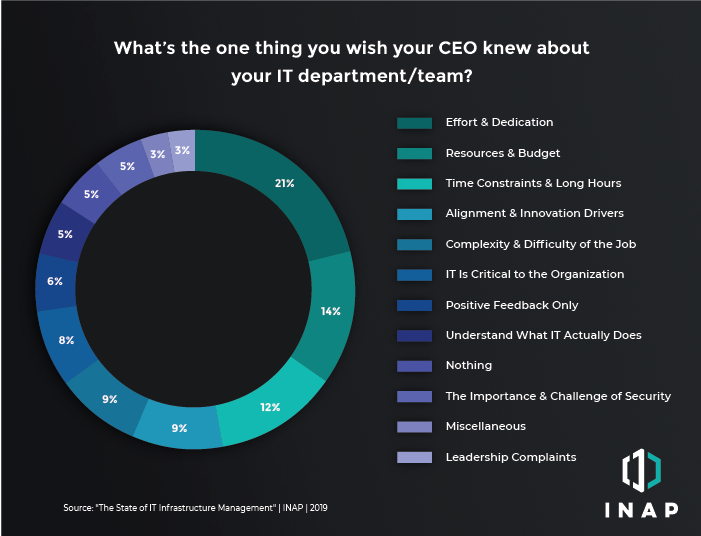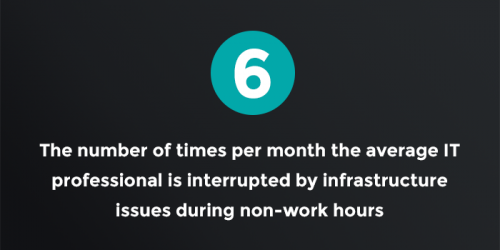Month: January 2019

When was the last time your CEO personally called IT? If it’s ever happened, it was probably because something was very, very wrong.
But expectations have changed, and IT has become a valued strategic partner to the business. As IT becomes more aligned with other departments, it only makes sense for the C-suite to be more proactive about creating open channels of communication with IT.
In other words, maybe the CEO should be calling IT—and not just because something is on fire. That’s why we had the idea to get the conversation going. We commissioned a survey of 500 IT professionals with data center, server and cloud infrastructure responsibilities who work at businesses and enterprises with more than 100 employees in the United States and Canada.
We asked them, “What’s the one thing you wish your CEO knew about your IT department/team?”
Their answers ranged from straightforward and simple to humorous and even impassioned. In our analysis, several themes emerged. What follows is a rundown of those themes and what we think they say about IT, along with 60 of the most colorful, insightful and interesting responses.
But first, here’s the distribution of all 500 responses classified by their overarching message:

Effort & Dedication
I wish my CEO knew …
- “How dedicated the team is to making certain every aspect is attended to as if it is the only priority for the company.”
- “How much work we put in to keep problems at bay; they only acknowledge us when something goes wrong.”
- “We work harder than any other department, but we still get the least amount of recognition.”
By a wide margin, the largest share of responses expressed a desire to merely be appreciated and acknowledged for the effort and dedication they bring to their jobs. This sentiment was echoed and expounded on in many responses that fit into other themes as well.
It might be expected that professionals from virtually every function in any organization would express this. But for IT professionals, feeling underappreciated is simply one way in which they feel pressured by their job, as you’ll see.
Resources & Budget
- “The cost of keeping us in the top tier of digital transformation.”
- “How hard we work and how much training we actually need to keep up to date with everything.”
- “How much of everything we accomplish is in the face of limited staff, education and resources.”
No surprises here: Many IT pros feel squeezed by a lack of resources, whether budget, training, headcount or all of the above. As the role of IT has expanded far beyond tech support and merely maintaining systems, it’s clear that IT pros don’t feel the amount of resources they are given has kept up with the growing scope of their responsibilities.
This issue is compounded by the fast pace of technological advancement and the continuous need for education and additional staff to properly leverage new technology.
And lurking beneath the call for greater resources is also the negative impact that staffing shortages have on the department as a whole.
- “How the lack of funding and consequential shortage of personnel affects the existing staff.”
- “Too many responsibilities to manage and monitor for a small IT staff. We get overwhelmed when everything goes wrong at the same time.”
As we covered in a recent blog on IT’s time, the question of morale—and its effect on effectiveness and efficiency in the IT department—is not one to be ignored, especially as the importance of IT’s role to the rest of the business continues to grow.
Alignment & Innovation Drivers
- “I wish the CEO knew exactly how many different areas that the IT department has some involvement in. From sales to marketing to human resources to finance, there is almost nothing that happens in the company that the IT department did not have a hand in.”
- “That we do more than manage and upkeep. We would like more projects that involve scaling the business—we can help with more than just maintenance of systems.”
- “By working together, we can align IT tech with business strategies to achieve goals faster.”
Organizations are looking to IT to lead digital transformation, and IT is stepping up to the challenge. This can only increase the value that IT brings to the business’s bottom line. Yet with this leveling up of the function’s strategic importance come the growing pains of shedding old notions about IT’s role in the business.
- “We do more than just fix computers.”
It’s old hat at this point to think of the IT role as primarily the help desk or computer troubleshooting, and it’s becoming clear that even the routine maintenance and monitoring of infrastructure is not where IT can deliver the most value to the business.
Instead, IT pros can and want to be more involved in managing digital transformation across the enterprise, in addition to turning the department into a true center of innovation.
- “Our true value to innovation, not just housekeeping.”
- “We are also an innovation center.”
IT Is Critical to the Organization
- “Know that in this day and age, the business would fail without our IT department keeping up with the latest technology.”
- “That we keep most of the business running. Without us, everything would be chaos.”
- “The overall importance to the entire organization and value we provide on a daily basis.”
- “Without us, you’re ****ed.”
Even as IT professionals want to be recognized for the value they bring to digital transformation and innovation, many also expressed a desire to be appreciated for the basic technological functionality that they ensure for the rest of the organization. The routine, the mundane, the day-to-day: Whatever you want to call it, it’s integral to the entire organization’s ability to function, yet many IT pros don’t feel that it’s treated as such.
On top of that, there is the sense that the important work goes on outside the visibility of the rest of the business, and thus unnoticed.
- “We work a lot behind the scenes to make sure that things work smoothly for all in the organization.”
- “How much effort goes into running and delivering quality IT solutions for multiple departments on a constant basis. My team works extremely hard to ensure the rest of the company can flow properly.”
Understand What IT Actually Does
- “I wish that they would spend some time shadowing us so they can experience everything we do and go through.”
- “That our day-to-day operations are a great deal more fluid than he thinks and that sometimes, deadlines just simply can’t be met due to unexpected issues.”
- “I wish the CEO knew about how many different responsibilities our department actually has and took the time to learn about what we actually do most of the time to see that it isn’t just about working with computers or servers.”
There is a lot to unpack here, but it all boils down to one thing: many IT professionals are frustrated that their CEOs seemingly just don’t get it. And when the CEO doesn’t know exactly what you do—or you’re not sure that they do (we’re not sure which is worse)—then you’re going to run into a host of problems.
One of these problems is unrealistic expectations, as explained in the quote above. And when your CEO doesn’t know the scope of what you’re doing, they won’t understand why you can’t do some things.
- “I wish the CEO knew how much we have to deal with during our day at work. It’s not just making sure that everything is working in the system and up and running; there are other little small things that keep us busy.”
- “How much we actually do each day.”
Likewise, another respondent pointed out how IT isn’t a “traditional” kind of job.
- “How IT doesn’t fit in to a cookie-cutter 8-5 job description.”
But many responses also just boiled down to a desire for their CEOs to understand and recognize the daily challenges of the job.
- “We do a lot more than we are given credit for.”
- “What we deal with.”
- “The day-to-day technical headaches we solve.”
Time Constraints & Long Hours
- “I wish my CEO knew that my IT department feels a little overloaded with too much work and not enough time to get any meaningful innovative work completed.”
- “How much extra time and effort we put in. We are working hard even when there aren’t any critical incidents or alerts.”
- “I wish my CEO was more aware of the actual time and effort that goes into running IT for our organization. Many employees put in long work hours, sometimes forgoing their own personal time to help the organization.”
As we covered recently, IT professionals are extremely conscious about the time they spend at work and what they do with it. As illustrated by some of the responses to this question, many wish their CEO knew about the amount of after-hours work they have to put in. Others are frustrated with the work getting in the way of value-added, innovative work.
Still others would like to have a healthier balance between work and their life outside of it. In our survey, we found that the No. 1 thing IT pros would do if given back 16 hours in their week is “reclaim work-life balance.” Given these responses, that’s probably no surprise, and the dangers of burnout are real, so this should be worrying.
- “How much extra work (pager/after-hours support, arriving early, staying late, etc.) that the IT department puts in on quite a regular basis.”
- “Our team works too many hours, and our work-life balance is really bad.”
The Importance & Challenge of Security
- “The challenge of staying ahead of cybersecurity threats.”
- “I wish the CEO understood the importance of security and IT’s role in that. As things are, we are just putting band-aids on servers to keep them running.”
- “[We are] keeping the organization’s applications and data safe, secure and available 24/7.”
Security is and will continue to be top-of-mind for IT professionals. Yet while the downsides of unsecured IT infrastructure and potential data breaches are well-known, many respondents don’t believe that their CEO is appropriately informed on either the importance of security nor how it is maintained.
Some responses pointed out the difficulty of assuring infrastructure security and the need for more resources.
- “How much time, energy and especially money it takes to run a secure infrastructure.”
Others highlighted the constant vigilance and effort required to stay ahead of information security threats.
- “The dedication that is put forth to keep the company up and running securely.”
- “How hard we work to keep the company’s data secure and our operation running smoothly.”
Still, others merely wished their CEO stayed current on the extent to which security is crucial to the business as a whole, especially in light of how relentlessly security threats appear and evolve.
- “How much security is needed [to protect] our information.”
- “The burgeoning threats with security concerns and infrastructure.”
Complexity & Difficulty of the Job
- “How hard and challenging my daily [job] is. I am human and can only do what is in my capacity.”
- “How our job is goes extreme relaxation to extreme stress in a minute when everything goes wrong at same time.”
- “How close we are at times to totally losing it.”
Many of the responses in this category partially relate to a desire for recognition for how stressful, complex and harrying IT jobs can be, as exemplified in the quotes above. Special emphasis was placed on how quickly a day can go from “normal” to crisis mode or the constant stress of maintaining the critical systems that the whole organization relies on.
Yet one of the most interesting takeaways is the extent to which many IT professionals see their roles as uniquely challenging. Given the rapid clip at which technology is developed and released, it’s no wonder that IT pros feel caught between mastering their current skill set while also keeping ahead of trends by picking up new ones.
- “I wish they understood how many different skills people in IT are supposed to master compared to basically everybody else at the company.”
- “All the different skills and knowledge [required] just for us to do our job and how quickly tech evolves.”
And this is something they believe is innate to the IT function and thus not properly appreciated by the rest of the business, including the CEO. But overall, the message still remains the same: IT pros want to be valued and appreciated for the effort they put in just to be competent at their roles.
Positive Feedback Only
- “We have a great CEO who is hands-on and involved with everything we are working on.”
- “The CEO knows exactly everything about our IT department. We have monthly meeting with board members and we have a very open-door policy.”
- “We have a great CEO that understands what we do and our value to the company.”
Encouragingly, there were a good amount of responses that showed a strong level of alignment and involvement between the CEO and the IT function. Most of these emphasized strong communication and a deep feeling of mutual understanding when it came to the value of IT, organizational priorities and goals, and operations. Nearly all of these responses referenced a regular cadence of communication, whether weekly or monthly meetings, formal or informal. Some made note of the CEO’s IT background, indicating that a demonstrated knowledge of IT’s technical role can make a big difference in ensuring alignment.
Leadership Complaints
- “I wish that the CEO had the technical knowledge to better understand both the limitations of technological products [and] the possibilities that these products bring to the business.”
- “Make himself more visible, present in our department.”
- “How our abilities are underutilized due to leadership’s lack of forward thinking.”
- “If he came in daily, that would be good.”
Though a tiny sliver of the responses, several IT pros identified specific leadership complaints about their CEO. They correspond to much of the positive feedback other respondents had. Specific complaints include a lack of technical knowledge, infrequent or poor communication and alignment, and a lack of vision for IT.
Miscellaneous
A handful of responses were very specific or didn’t otherwise fit into a broader category. Here is a sample:
- “We need more freedom.”
- “The organizational structure is not reflective of talent and abilities.”
- “We aren’t all geeks.”
- “Trust our experience and knowledge.”
- “Data quality issues we have that aren’t prioritized seriously.”
- “[Our] mission for the future.”
Nothing
- “Nothing.”
Some respondents simply said that there was nothing they wish their CEO knew … or maybe they were just eager to get back to work.
Seeking insights for success? Explore HorizonIQ’s strategies for businesses like yours.
Explore HorizonIQ
Bare Metal
LEARN MORE
Stay Connected

The holiday season and transition to the new year can always get busy, and here at INAP, that certainly proved true. As the first month of 2019 winds down, check out this quick recap of recent news coverage and thought leadership from around the web.
Hosting Advice
“IT professionals want to be doing more—leading transformations in terms of digital and IT strategies,” TJ Waldorf, INAP VP of global marketing told Hosting Advice. “But they’re bogged down with the mundane: Making sure the servers are up and running, routine monitoring and maintenance. We’re trying to be the one-stop-shop that gives them time back so they can focus on innovating and delivering on their missions.”
Read more about how we’re leveraging our whole product portfolio to enable purposeful, performance-driven digital transformation for our customers.
Tech Republic
Tech Republic covered our recent survey report, The State of IT Infrastructure Management, highlighting that nearly 8 in 10 IT professionals believe they could bring more value to their organization if they spent less time on routine tasks and more time on innovative, value-added tasks. We’ve been diving into the survey in depth on the ThinkIT blog, so check out our insights to learn more.
CSO
“The scale and velocity at which we see changes when you’re utilizing APIs—it can be challenging to keep up with that. It’s the nature of where we are, and of working in the cloud space. It’s evolving very rapidly. It’s constant upkeep,” Jennifer Curry, INAP SVP of global cloud services, told CSO online in an article covering the shifting security challenges of the cloud.
SmarterMSP
“As the application workload environment continues to evolve, it’s clear there will be greater demand for managed services that not only span multiple clouds, but also on-premises IT environments,” writes Mike Vizard in SmarterMSP. He cites findings from our survey, The State of IT Infrastructure Management, to highlight the growing pains of IT’s shift to the cloud and the ways that managed service providers can ease the transition.
Information Management
In Information Management, Jennifer Curry asked, “What does a chief information officer actually do?” Spoiler alert: the answer is more complex than it seems at first. TL;DR CIOs can be more than the head of the IT function, and as IT evolves, they have to be. Read the rest to find out why.
datacenterHawk
Rich O’Dea, INAP SVP of sales, was featured on datacenterHawk to talk about our rebrand, the importance of network connectivity and performance in the age of the edge, and how our comprehensive colo, cloud and network solutions are simplifying IT for our customers.
Chicago Business Journal
At the end of the year, INAP’s acquisition of Chicago even made it onto Chicago Business Journal’s biggest Chicago tech acquisitions of the year. We knew we were a big deal, but it’s always nice to hear it from someone else too.
BetaNews
In BetaNews, SVP and Chief Administrative Officer John Filipowicz shared his tips for bridging the IT skills gap for employers and employees alike—both practical and strategic. His final takeaway?
“No one company or individual can “solve” the IT skills gap, but there are things both can start doing today that will make a tangible difference in the future.”
Explore HorizonIQ
Bare Metal
LEARN MORE
Stay Connected

Too Much and Not Enough: Why Cybersecurity Is IT’s Top Challenge for 2019
One in four servers at the average enterprise is not fully up to date with the latest security and software patches, according to INAP’S new survey, The State of IT Infrastructure Management. And that’s not all: A majority of IT pros believe that the time it takes their team to address critical patches and updates leaves their organization exposed to security risks, meaning that the 25 percent of unpatched servers aren’t being addressed as quickly as they should be.
Factor in that patching is but one of many activities required for a comprehensive, Defense in Depth approach to cybersecurity, and there’s good reason to be alarmed. With daily reported (and numerous unreported) data breaches and the ever-present danger of human error, the task of maintaining enterprise cybersecurity has clearly become an enormous responsibility—and far too important to neglect.
So why are routine security tasks not being taken care of? It’s certainly not because security isn’t top-of-mind for IT professionals. When asked about their No. 1 challenge leading into 2019, over a third (36 percent) identified “protecting the organization from cyberattacks.”
Perhaps the answer then is deceptively simple: Cybersecurity is difficult, and it’s time-consuming work on top of already-full plates. Let’s dig deeper into what that means for enterprise IT infrastructure management and more importantly, what organizations can do about it.
The Need for Greater Security and the Move Off-Prem
What’s driving IT infrastructure away from on-premise?
When asked about the primary reasons for moving on-premise infrastructure to colocation or the cloud, nearly four in 10 survey respondents cited the need to “improve infrastructure or data center security.” This answer makes a lot of sense when you consider the immediate physical security benefits of hosting or colocating in a state-of-the-art data center, including round-the-clock personnel and multiple layers of access checkpoints before anyone gets close to a cage.
But data center security only takes you so far. The overall success of a security strategy hinges on how infrastructure, networks and applications are designed and maintained. Regardless of platform, this begins with smart solution architecture and continues across all layers with robust user access control, as well as 24/7 monitoring and log management to quickly identify potential breaches.
To be as secure as possible, your infrastructure must be designed from the start with your particular applications and security needs in mind.
As companies widely adopt hybrid and multicloud strategies, many find that working with trusted partners is crucial to not letting a growing attack surface overwhelm internal resources.
The No. 1 Quality Most Needed in an Infrastructure Solution
Given the damage that data breaches inflict on both bottom lines and reputations, it’s no surprise that 37 percent of our survey respondents identified security as the No. 1 quality they look for in an infrastructure solution.
The No. 2 answer—ease of system monitoring and management—is closely linked to security, as well. In a piece for CSO, INAP SVP of Global Cloud Services Jennifer Curry spoke about the challenge of systems monitoring and management in the age of the multicloud.
“The traditional monitoring tools don’t work in these environments,” she said. “You don’t have access to the network. You don’t have access to the underlying infrastructure.”
While this makes the daily—and critical—work of maintaining and optimizing your infrastructure challenging, visibility is key to security, especially as the average enterprise now hosts workloads across multiple data centers and clouds and uses countless more SaaS services.
Without a single, high-level view into the health and status of all these systems, the challenge of managing security in-house will only grow.
Too Much and Not Enough: The Catch-22 of Infrastructure Security and IT’s Time
To recap: Enterprise IT infrastructure is not as secure as it should be, due in part to everyday vulnerabilities like unpatched servers and an ever-growing attack surface. IT professionals are both aware of and worried about their organizations’ vulnerability, so what’s the missing piece?
Like so many things, it’s all about time.
Our survey found that only 60 percent of respondents’ job responsibilities are directly related to infrastructure. But as we covered in a recent blog on IT’s time, how they spend it and what they think about it, eight in 10 survey respondents identified at least one server- or cloud-related infrastructure task they spend too much time on. Nearly the same likewise identified a task they don’t spend enough time on.
Most compellingly, roughly the same amount said they spend too much time on information security management (24 percent) as those who said they don’t spend enough time on it (22 percent). While this divide at first seems puzzling, it’s very likely that those who say they spend too much time on it aren’t saying that because they don’t think it’s important.
Rather, the issue may be whether they believe that it takes up an appropriate amount of time relative to IT pros’ desire to devote more time to value-added tasks—not just the fundamental responsibility of “keeping the lights on.” And it brings up a related question: In 2019 and beyond, are routine security tasks and checklists a good use of the IT function’s time, given the need for IT to drive digital transformation?
Enterprise Security and the Question of Resources
IT pros feel crunched for time, so much so that some feel they don’t have enough time to devote to what they identify as their top challenge and priority for the year. From all sides, they’re being asked to do more with fewer resources than they feel they need.
Case in point: When we asked what one thing they wish their CEO knew, many respondents specifically mentioned feeling under-resourced to ensure enterprise security.
“I wish my CEO knew how much time, energy and especially money it takes to run a secure infrastructure,” one said.
For many organizations, adding more security-focused IT headcount is not a true option, no matter how much the function may need it. So what can IT do?
One straightforward way is to partner with an IT service partner, who can use both their resources and resources to take care of the routine security tasks falling through the cracks, while also giving IT much-needed breathing room to do the work that matters: the value-added work of digital transformation and innovation.
Explore HorizonIQ
Bare Metal
LEARN MORE
Stay Connected

How often do urgent work issues interrupt your non-work hours?
If you’re the average IT pro, you’re picking up the phone or getting out of bed and rushing to your computer six times a month to address IT infrastructure issues, according to our latest survey, The State of Infrastructure Management.
This may be surprising to those outside the function, but the reality is that IT is always on call to ensure that critical systems are up and running—a monumental task in and of itself.
But as IT has transformed into something more than just the help desk or the ones who “keep the lights on,” it’s hard to get over the fact that infrastructure upkeep is interrupting—and blocking—more value-added activities. Nearly eight in 10 respondents to our survey believe they could bring more value to their organizations if they spent less time on routine tasks like server monitoring and maintenance.
This isn’t IT wanting to jettison responsibility just because it’s tedious or hard.
It’s IT pros recognizing that they could be adding more value to their function and their organization—if only they had the time.
How IT pros spend their time is not just a matter of individual value; it’s about maximizing the value of the IT function as a whole, increasing productivity and morale, and remembering the human element behind the IT infrastructure that powers the entire enterprise.
The Problem of Morale
We asked 500 IT professionals: If you got back 16 hours of your week normally devoted to routine infrastructure tasks, what would you do with that time? Their No. 1 answer? Reclaim work-life balance.
It’s hard to read this as anything more than a warning sign of the downsides of IT pros feeling overworked—or even underappreciated, as we found when we asked respondents about the one thing they wish their CEO knew about their role. Many identified both the long hours and the lack of recognition for the unique value IT brings to the enterprise.
“I wish my CEO knew how close we are at times to totally losing it,” one said. “I wish my CEO knew how much work we put in to keep problems at bay; they only acknowledge us when something goes wrong,” said another.
Maximizing the value IT contributes to the business as a whole is just as much about what IT practitioners do as how they feel about it. To have an innovative IT organization carrying out value-added initiatives, not just scrambling to maintain and keep up, the IT pros doing the work need the time, energy and motivation to do so.
How can you ensure you have all three? We’ll get to that later. First, let’s turn to what IT is actually spending their time on—and what they’re not.
The Value-Added Activities IT Wants to Be Doing
Roughly the same amount of IT pros (82 percent) have one server- or cloud-related task they believe they spend too much time on as those who have one task they believe they don’t spend enough time on (77 percent). This indicates a widespread dissatisfaction with day-to-day time allocation among IT pros.
By and large, tasks they spend too much time on are all related to the routine maintenance and upkeep of infrastructure, whether OS or hardware maintenance, server room/data center management, user administration and access control, or monitoring. It’s no wonder then that these are the tasks IT would choose to offload if they could, in favor of more value-added activities.
What are those? The IT pros we surveyed identified two main tasks they don’t feel they spend enough time on: 1.) designing or implementing new solutions and 2.) server migration, expansion and upgrades. Both activities indicate a desire to continue exploring how to further develop the IT organization’s ability to meet the future needs of the business.
The takeaway? IT is hungry to do more, to bring more value through forward-thinking, strategic work, but they feel blocked because they lack the time and resources to break from the never-ending work of upkeep.
So then the question is: What can you do about it?
The Power of Removing Responsibilities
You may have already picked up on the deceptively straightforward answer to the problem of IT’s time under siege: removing the day-to-day routine tasks of maintenance and upkeep. But of course, the hard part is not identifying what to do but how to do it.
That being said, start with looking at the tasks your IT can and should handle in-house and what can be offloaded. Once you’ve identified for your own organization what you can and should take off your IT organization’s plate, finding a trusted managed services provider is one highly effective way to free up time.
They can handle the tasks that are getting in the way of your IT team’s ability to move the needle for your business’s digital transformation and innovation efforts. But beyond that, you will be creating space for IT professionals to reclaim the mental energy, time and resources—both individually and collectively—that they need to maximize their contributions and value to the business as a whole.
Explore HorizonIQ
Bare Metal
LEARN MORE
Stay Connected

Latency for the Layperson: Understanding Network Performance, Latency and Why it Matters
In this blog post, I will explain the basic terminology of network speed and latency, in addition to ways that we reduce latency at the network level, so you can walk away knowing the foundational concepts and their importance to mitigating latency—and why it’s important.
This blog will focus on enterprise latency considerations. End users or consumers can experience sluggishness due to non-network-related factors like a slow internet service (e.g., dial up, satellite or ISP traffic management issues) or traffic congestion in their local intranet due to heavy internet usage or many people engaging in high-bandwidth activities—like when an entire family is watching video streaming on different devices on the same network at their house.
Defining Latency, Packet Loss, and TCP vs. UDP
You may have heard of network latency before. Put simply, latency is how long it takes data to travel between a source and destination on a network, plus how long the response takes to return. This measurement is called Round Trip Time or RTT. It’s measured in milliseconds.
The unit of data is referred to as a packet, i.e., whatever is being transmitted and received. A packet could be an HTTP request between an end user’s browser and their favorite website, the inputs generated by a gamer playing their favorite MMORPG, or any other data transmitted via internet protocols.
Packet loss occurs when one (or more) packets of data traveling across a computer network fail to reach its destination. It is caused by errors in data transmission or network congestion, and it’s measured as a percentage of packets lost with respect to packets sent.
Different control protocols handle packet loss differently.
Transmission Control Protocol (TCP) handles packet loss and automatically retransmits the missing packets. It also controls the speed of transmission and is able to slow down traffic flows when loss is detected. This is abstracted from software developers and allows them to focus on the app itself.
User Datagram Protocol (UDP) takes a hands-off approach to packet loss, allowing the developer to handle how retransmission takes place—if at all.
TCP is appropriate and preferred for most applications, with the exceptions being streaming media or data, (think music, video, gaming, telephony) where it is preferable to lose a few packets rather than pause the stream to wait for retransmission to happen. These kinds of applications tend to leverage UDP and define their own packet loss mitigation approach.
What’s the Importance of Low Latency?
While one benefit of any high-performance network is low latency, the extent to which any given organization or IT function requires the lowest possible latency will differ depending on the applications being deployed. For example, an application that serves web ads must have as low latency as possible in order to make sure that valuable time isn’t lost loading an ad on a web page. Likewise, a gaming company requires ultralow latency for its servers so that players have an experience that is as smooth and responsive as possible.
Factors That Impact Latency
Latency is impacted by several factors, including the hardware in place (number of devices in path, link/device utilization and any network cable or hardware issues), and most importantly, the geographic distance the packets travel.
Latency and Border Gateway Protocol
Border Gateway Protocol (BGP) routing is used between large ISPs and IT environments so that there is a shared and agreed-upon way to exchange routing information to allow for data to “hop” through each autonomous network to its destination. BGP uses a model of Autonomous System (AS) paths to determine what it believes to be the shortest, fastest path. Unfortunately, AS path in no way takes into account latency, only the number of discrete organizations (or ASNs) between source and destination networks.
Previously, we wrote about BGP and how its default settings can lead to high latency. In summary: BGP does not have a built-in way to avoid network congestion and slowdowns, whether due to high traffic, malfunctioning hardware or any other latency-increasing factor.
Reducing Latency, the HorizonIQ Way
HorizonIQ takes great pride in our network and works diligently to ensure customers have the best and lowest-latency experiences. We make sure that the network gear we deploy is correct for the network position, with low latency switching close to the customer devices, while also using deep buffer devices at core locations to protect against microbursts in traffic and stop retransmissions before they’re even sent.
Finally, and most importantly, HorizonIQ customers can take advantage of Performance IP, our automated route optimization engine. It watches popular destination IP prefixes, and it automatically puts all of our customers’ outbound traffic on the fastest, most stable routes and providers. Check out the video below to learn more about how it works or jump straight to a demo.
Explore HorizonIQ
Bare Metal
LEARN MORE
Stay Connected

IT is moving into the future, growing beyond its traditional role to become a center of innovation—so then why are conversations about IT performance stuck in the past?
Too often, the discussion starts with the hard numbers of quantitative performance, what I call “speeds and feeds”: details like what kind of processor, memory size, disk I/O or throughput. The problem is that using these metrics to evaluate the performance of your IT—whether solutions, service providers or the organization itself—comes hopelessly short of determining the value that IT is bringing to its new task of leading digital transformation.
Don’t get me wrong, measures of technical performance are of vital importance. But once you’ve ensured that you have the technical performance required to power your applications, what’s next? What does IT performance mean for the complex, interconnected, innovative IT organization of today and tomorrow?
At the end of the day, each technical metric supports a greater business objective, whether that is fixing a problem or driving business transformation for an organization. The definition of IT performance must transcend “speeds and feeds” to encompass what technical performance enables your IT and your company to do, or in other words, how your IT is supporting your organization’s purpose.
That’s the true measure of value when it comes to IT. So how do you get there?
The Right Data Used in the Right Way
One of my serious hobbies is racing cars, and whether I’m on or off the track, measuring performance is of utmost importance. Optimizing my race performance relies on capturing and analyzing data, but it’s not enough to just know the max speed or how much horsepower I’m working with. That kind of data has to be tied to and measured against outcomes.
How is IT moving the needle for the organization? What tweaks can IT make to improve the performance of your applications? How can IT contribute more value to the business? The answers to these questions have to start with a focus on the right data and then be tied to how it actually impacts outcomes.
For example, 99.999 percent uptime and ultra-low latency are certainly features of many high-performance IT solutions. But if it’s unclear to you why five 9s or shaving 10 milliseconds off your average latency matters, whether it even matters at all, or what it means for your applications and your business, then these numbers aren’t truly helping you make decisions about performance; they’re just numbers.
And with more technology than anyone could possibly use coming out at a rapid clip, understanding the data that matters to your applications and using it to decisively evaluate new tech becomes even more key.
High-Performance IT Solutions Create Room to Focus
Once it’s clear what data matters to your business and why, the continuous process of evaluating and optimizing the performance of your IT solutions can begin. Distinguishing the signal from the noise creates the space needed to get the most of your IT infrastructure and providers.
One straightforward way to do this is to determine which activities and functions are important for your IT organization to control and which can be offloaded to an IT service partner. According to our new survey, The State of IT Infrastructure Management, nearly 8 in 10 IT pros believe they could bring more value to their organization if they spent less time on routine tasks like server monitoring and maintenance.
Add to that the fact that 85 percent of our survey respondents also believe IT must be seen as a center of innovation to succeed. But that’s clearly a challenge given the time and effort devoted to routine tasks.
How much more could your IT organization accomplish with the time you’re getting back by offloading those tasks? That’s for you to discover.
And when you know what tasks are holding value-added, purposeful work back, allocating resources to digital transformation and other mission-critical initiatives will only get easier.
Changing Expectations and Differentiated Performance
We’re past “speeds and feeds”: It’s taken for granted that hardware specs will be state-of-the-art. In many cases, compute power is beyond what applications can even use.
In this landscape, enterprise IT organizations aren’t just looking for performance. They’re looking for differentiated performance provided by the kind of products and services that can increase operational performance above and beyond other solutions—without adding time or complexity to IT organizations already stretched thin.
This is exactly why we’re so proud of Performance IP, our patented route optimization engine, which uses intelligent automation to put outbound traffic on the lowest latency route, without any need for human intervention.
But it’s not just about services that other IT providers may not have; it’s about creating visibility and predictability and how that can unlock unrealized operational efficiency and better decision-making—just by taking things off our customers’ plates.
Technology is on the bleeding edge, but IT organizations aren’t necessarily in the same position. IT doesn’t have to be slow-moving. The sign of a high-performance IT solution or service provider is that they are enabling your organization to focus on what matters: agility, innovation, staying ahead of the rapidly developing technology and empowering your purpose.




















